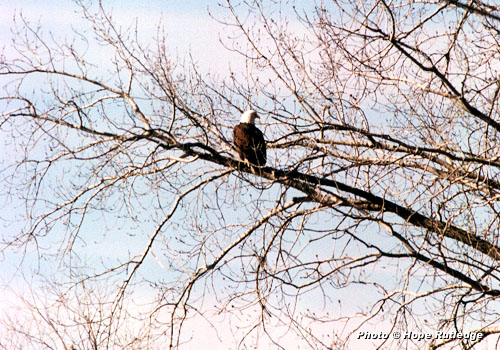 |
 |
 |
 |
| Scientific name - Haliaeetus leucocephalus Eagles are a member of the Accipitridae family, which also includes hawks, kites, and old-world vultures. Scientists loosely divide eagles into four groups based on their physical characteristics and behavior. The bald eagle is a sea or fish eagle. There are two subspecies of bald eagles. The "southern" bald eagle, Haliaeetus leucocephalus leucocephalus, is found in the gulf states from Texas and Baja California across to South Carolina and Florida, south of 40 degrees north latitude. The "northern" bald eagle, Haliaeetus leucocephalus alascanus, is found north of 40 degrees north latitude across the entire continent. The largest number of northern bald eagles are in the Northwest, especially in Alaska. The "northern" bald eagle is slightly larger than the "southern" bald eagle. Studies have shown that "northern" bald eagles fly into the southern states and Mexico, and the "southern" bald eagles fly north into Canada. Because of these finding, the subspecies of "northern" and "southern" bald eagles has been discontinued in recent literature. |
| Bald eagle body description Color - The adults have a blackish-brown back and breast; a white head, neck, and tail; and yellow feet and bill. Juvenile bald eagles are a mixture of brown and white; with a black bill in young birds. The adult plumage develops when they're sexually mature, at about 4 or 5 years of age. The bald eagle is the only eagle confined to North America, and there are no other large black birds in North America with white heads and tails. Size - The female bald eagle is 35 to 37 inches, slightly larger than the male. With a wingspan which varies from 79 to 90 inches. The male bald eagle has a body length from 30 to 34 inches. The wingspan ranges from 72 to 85 inches. Bald eagles weigh from ten to fourteen pounds. Northern birds are significantly larger than their southern relatives. Bald Eagle Population Map |
 |
| Body Temperature - 102 degrees Fahrenheit (38.8 degrees Celsius) Tolerance to cold temperatures - A bald eagle's skin is protected by feathers lined with down. The feet are cold resistance because they are mostly tendon. The outside of the bill is mostly nonliving material, with little blood supply. Fidelity - Once paired, bald eagles remain together until one dies, the survivor will not hesitate to accept a new mate. Voice - Shrill, high pitched, and twittering are common descriptions used for bald eagle vocalizations. Eagles do not have vocal cords. Sound is produced in the syrinx, a bony chamber located where the trachea divides to go to the lungs. Bald eagle calls may be a way of reinforcing the bond between the male and female, and to warn other eagles and predators that an area is defended. Skeleton - It weighs about half a pound (250 to 300 grams), and is only 5 or 6 percent of its total weight. The feathers weigh twice that much. Eagle bones are light, because they are hollow. The beak, talons, and feathers are made of keratin.Life expectancy - Wild bald eagles may live as long as thirty years, but the average lifespan is probably about fifteen to twenty years Eagles sit at the top of the food chain, making them more vulnerable to toxic chemicals in the environment, since each link in the food chain tends to concentrate chemicals from the lower link. |
| The wings and soaring - An eagles wings are long and broad, making them effective for soaring. To help reduce turbulence as air passes over the end of the wing, the tips of the feathers at the end of the wings are tapered so that when the eagle fully extends its wings, the tips are widely separated. To help them soar, eagles use thermals, which are rising currents of warm air, and updrafts generated by terrain, such as valley edges or mountain slopes. Soaring is accomplished with very little wing-flapping, enabling them to conserve energy. Long-distance migration flights are accomplished by climbing high in a thermal, then gliding downward to catch the next thermal, where the process is repeated. The tail - is very important for flight and maneuvering. While the bald eagle is soaring or gliding in flight, the tail feathers are spread, in order to attain the largest surface area and increase the effect of thermals and updrafts. The tail also helps to brake the eagle when landing and assists in stabilization during a controlled dive or swoop toward prey. The strength of the feathers and the follicles holding the feathers is quite impressive, while watching the tail move back and forth and up and down during maneuvers. |